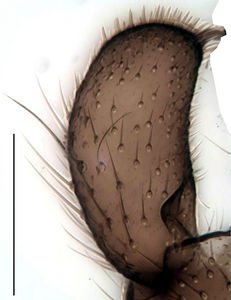Trichosiopsis claviforceps
Ordo: Diptera
Familia: Sciaridae
Genus: Leptosciarella
Name
Leptosciarella claviforceps (Tuomikoski, 1960) – Wikispecies link
- Trichosia (Leptosciarella) claviforceps Tuomikoski, 1960[1]: 25, fig. 5b
- Leptosciarella (Leptosciarella) claviforceps (Tuomikoski, 1960)[2]: 78, fig. 27
Type material
Holotype: ♂, 04.07.1958, leg. Tuomikoski im MZH
Type locality
Finland, Kuusamo, Oulankajoki
Material studied
Finland: 1 ♂, Le, Enontekiö, Annjaloannji, Malaise trap, Jussila, 11.-15.07.2007, MZH 9206; 1 ♂, Li, Inari, Tsarmi puro 2, Malaise trap, Salmela, 27.08.2004, MZH 9207; 2 ♂, Le, Kilpisjärvi, Jakovlev & Penttinen, 2006, MZH 9205/9246; 3 ♂, Tb, Kolari, Konnevesi, Korpi jakso 9, Penttinen, MZH 9202-9204; 2 ♂, Kuusamo, Ks, Saaripuro, Malaise trap, Salmela, 03.05.2005, MZH 9200/9201; 1 ♂, Ks, Raatepuro, Malaise trap, Salmela, 03.08.2005, MZH 9347; Norway: 3 ♂, Varangerhalbinsel, Finmark, Vadsö, Laubwald, Birke, Zwergsträucher, exhaustor, Jaschhof, 12.07.1994, PWMP 1792-1794; Russia: 1 ♂, Jushnyi Yamal, Olschwang, 25.07.1981, PWMP 1791; Sweden: 1 ♂, Lule lappmark, Kabdalis, Norrbottens län, Suorke Reserve, swamp forest (spruce, birch aspen), Malaise trap, Viklund, 31.5.-23.09.1983, NHRS 282; 3 ♂, Pite lappmark, Arjeplog, Norrbottens län, L. Sädvajaure (northern end); subalpine birch forest, Malaise trap, Jaschhof & Jaschhof, 7.7.-12.08.2005, NHRS 997/1157, PKHH 5864; 6 ♂, Torne lappmark, Nikkaluokta, Norrbottens län, young birch/willow forest along stream, Malaise trap, Jaschhof & Jaschhof, 14.7.-05.08.2005, PKHH 5929/5941, NHRS 1061/1074, ZSMC 2407/2408.
Description (male)
Head. Eye bridge 4 rows of facets. LW-index of 4th antennal flagellar segment 1.8–2.3; neck 0.19–0.28 of segment width; Transition of basal part to neck pronounced. Colour of neck unicolour. Antennal hairs shorter than segment width; sparse; salient. Palps darkened; normal; palpomeres 3. First palpomere of normal shape; with 3–5 bristles; with only some sparse sensillae. Second palpomere shortly oval. Third palpomere as long as first segment. Thorax. Colour brown. Notum unicolorous. Thoracic setae normal; darkened. Mesonotum with some weaker central bristles. Posterior pronotum setose. Postpronotal setae 2–3; fine. Laterotergite bare. Legs. Colour yellow. Hind coxae of same colour as femora. Hairs on fore coxae bright. Front tibia apically with a patch of setae. Front tibial organ bright. Front tibial organ not bordered. Tibial setae on hind legs normal, shorter than tibial width. Tibial spurs of equal length. Claws untoothed. Wings. Wings slightly darkened; of normal shape. Wing membrane without macrotrichia. Wing venation weak, with faint m-base. M-fork of normal shape. R1 inserting clearly before base of m-fork; posterior veins with macrotrichia, or bare; stM with a few macrotrichia, or bare; cuA1 and cuA2 bare; bM bare; r-m with a few setae; bM:r-M 0.6–0.8; st-Cu:bM 0.7–0.9; r1:r 1.1–1.4; C:w 0.7–0.8. Halteres bright; of normal length. Abdomen. Abdominal setae weak; dorsally dark; ventrally white. Hypopygium concolour with abdomen; 0.55–0.67 × longer than wide. Base of gonocoxites with normal, weak hairs; gonocoxites narrowly separated; inner margin of gonocoxites normally U-shaped; inner part of hypopygium scarcely setose; elongated setae on valves of hypopygium absent. Gonostylus elongate; 2–2.4 × longer than wide; Inner margin straight, or concave; apex equally rounded. Apical tooth present; 2.1–2.6 × longer than broad; normal. Awl-like setae normal; on inner side of gonostyles present apically. Megasetae on inner part of gonostylus absent. Whiplash-hair absent. Tegmen 0.4–0.6 × longer than broad; rectangular with rounded edges; with dark and strengthended edges; Central process absent. Length of aedeagus/hypopygium 15–25 %; Aeadeagal apical structure absent. Measurements. Body size 2.5–3 mm. Hind tibia 1.31–1.45 mm. Wing length 2.6–3 mm.
Diagnosis
Leptosciarella claviforceps is characterized by the parallel, apically equally rounded and slightly broadened gonostyles together with the absence of macrotrichia on the posterior wing veins. Only rarely some vestigial macrotrichia are present on the m-fork or the m-stem. The tibial organ consists of bright setae in contrast to most other species of the genus, in which they are usually dark.
Discussion
By the rounded gonostyles this species belongs to the viatica-complex of species and here to the subgroup of species with reduced macrotrichia on the wing veins.
Etymology
lat. clava = club, forceps = pincers; making reference to the club-shaped gonostyles.
Ecology
Leptosciara claviforceps is a strictly boreal species, which occurs northern to 65° N.
Distribution
Finland[1], Norway, Russia[2], Sweden[3][4].
Images
|
References
- ↑ 1.0 1.1 Tuomikoski, R. 1960: Zur Kenntnis der Sciariden (Dipt.) Finnlands. Annales Zoologici Societatis Zoologicae Botanicae Fennicae “Vanamo”, 21, 1–164.
- ↑ 2.0 2.1 Mohrig, W.; Menzel, F. 1997: Revision der paläarktischen Arten von Trichosia Winnertz sensu Tuomikoski, 1960 (Diptera, Sciaridae). – Teil II. Gattungen Leptosciarella Tuomikoski, 1960 und Trichodapus gen. nov. Studia dipterologica, 4(1), 41–98.
- ↑ Rudzinski, H.-G. 1992: Neue Mitteilungen zum Vorkommen von Trauermücken in Schweden (Diptera: Nematocera: Sciaridae). Entomologische Zeitschrift, 102, 66–72.
- ↑ Heller, K.; Vilkamaa, P.; Hippa, H. 2009: An annotated check list of Swedish black fungus gnats (Diptera, Sciaridae). Sahlbergia, 15(1), 23-51.







